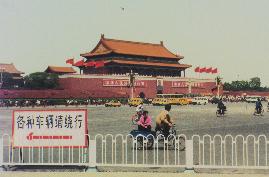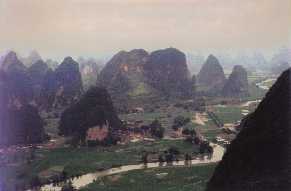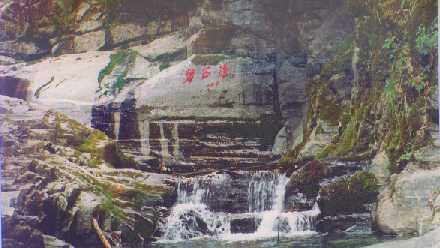This is a photo essay describing four months I spent shoestring-traveling
around Asia in the spring and summer of 1993. I began my journey by flying
across the Atlantic to Europe, and, after visiting a few friends there, took a
train to Moscow. The Trans-Siberian brought me from there across most of the
width of the Asian continent to Beijing. In China, I worked my way first
southward then westward, then finally northward to Chengdu, in Sichuan
Province, completing a great "U" over the course of six weeks. From Chengdu I
flew westward into Tibet (overland travel for this leg would have been
difficult or impossible), and I continued westward and then southward into
Nepal via jeep. In Nepal, I stayed for three weeks, going for a Himalayan
trek and resting in Kathmandu. After this, I headed south into India, where,
although it wasn't the hottest time of the year (this was supposedly May and
June), it was still pretty darn hot (I was there in late July-early August).
I spent little time there but headed further southward almost right away, down
to Madras in the very southern tip of India, and hopped over to Sri Lanka,
where I spent just two weeks. At last came the extended journey homeward:
four days in Bangkok, one in Seoul, and five in Tokyo (with flights in
between) before catching the final flight home across the Pacific.
The images below here are a small selection of my pictures from the trip,
presented in more or less the order they were taken. I'm afraid they haven't
all come out so well (my skills with the scanner still have a long way to go),
but I hope they still manage to convey something of the feel of these faraway
places... Also note that, given the size of the pictures, the formatting on
this page works best in a browser window around 800 pixels wide or less.

|
During forty years of communist rule in Czechoslovakia, standards of
living declined relative to the West. But the government put great
energy into building stark, hypermodern-looking megalithic structures
to remind people of its progressive ideals and to encourage a break
with the past. The Prague subway was one example - straight lines,
metallic surfaces, and a complete lack of decorative adornement
carried the impression across quite strongly that a new era had
arrived. A strange contrast with the relatively poor and backward
state of things above.
|
|
|
|
It was a shock to travel to Russia, so long feared and respected as a
powerful enemy, and see how poor conditions there actually were. Out
on the farms I saw fields being tilled by human power alone - no
tractors or even ox-drawn plows. In the cities, buildings everywhere
were in disrepair, and order seemed to be barely hanging on against
pressing chaos. I was surprised to see how little variety of food was
available, even in the best hotels. On the Trans-Siberian, the dining
car on the train had very little that was appetizing, and instead we
bought food from local entrepreneurs at stations like this one. A
loaf of odd-tasting bread, perhaps a cucumber, and occasionally when
we were lucky we could find someone selling boiled potatoes.
|
 |
|
|

|
In Eastern Siberia I changed trains to the Trans-Manchurian which
descended through the vast steppes east of Mongolia to Beijing. For
three days we traveled through open, grassy land stretching out and
away, unbroken, to the horizon. On the other side of this vastness
lay China, a completely alien culture. It was easy to see why it
developed in independence from neighbors to the north and west.
|
|

|
In Beijing's Tiananmen Square, the picture of Mao Zedong, leader of
the communist revolution, hangs above the entrance to the Forbidden
City, the grand palace complex of the former emperors of China. Such
a display blatantly grafting the new onto the old would be unthinkable
in the West, but here it typifies the Chinese people's attitude of
acceptance toward their government's actions and statements.
|
|
|
|
Over the centuries the Chinese developed gardening into a beautiful
art expressing philosophical ideas of man's relationship with nature.
The city of Suzhou is famous for the gardens constructed there by
retired government officials, which are so cleverly laid out that it
is possible to walk a mile or more through a garden of only a couple
of acres, weaving and crisscrossing, now above, now below, without
ever gazing upon the same view twice. Wonderfully, the gardens were
also residences, with living structures ranging from gazebos to small
two- to three-room buildings distributed through them, blended
unobtrusively with water, rock, and plant. Each garden is a microcosm
expressing the ideal of rich harmony between man and landscape.
|

|
|
|

|
The countryside around Yangshuo in southern China
is one of the most beautiful places I've ever been. The landscape was
so fantastic I could have been dreaming, but when I was there it
seemed like the ordinary world of my past was the dream.
|
|
|
|

|
One of the best things about traveling in Asia was meeting other
travelers from different Western countries and backgrounds and
exploring together, reacting to the exotic surroundings in ways that
were similar enough for mutual understanding, but different enough to
expand our outlooks. The two women here, Antje and Susanne, were
German interior decorators who saved money to take long trips every
couple of years. The man, Gunther, actually traveled almost full
time, earning enough money from slide presentations he put on back in
Germany for a couple of months each year to support himself on the
road for the remainder.
|
|
|
|

|
|
|
In southwest China, the land is mountainous and built on a grand and
magnificent scale. Towering, wall-like mountains and sweeping vistas
charged my soul and carried it surging to a higher level.
|
|

|
|
|
|
One time I hiked up over trackless ground to a Buddhist monastery
situated halfway up a mountainside. Much to my surprise when I got
there I found a marvelously constructed stone path leading from
behind the monastery further up the mountain. I followed it
up and then along sheer walls to a place where a stream came crashing
down from above. A branch of the path led up along the stream, and
following this I came to a remarkable series of waterfalls, each with
a little sidepath leading to the water's edge so that it might be
contemplated with greater immediacy. A name was carved in characters
into the rock above each falls, but these did not seem disfigurements
to the natural surroundings. I wished I could read them.
|

|
|
|

|
Another time a Frenchman I met and I decided to partially climb a
17,000 foot peak that was several miles outside the town where we were
staying. We hired a motorcycle-sidecar taxi to take us out there, but
the driver must not have known what he was getting into because he ran
out of gas on the way out! Luckily a bus driver came by who happened
to be a friend of his, and he was able to top us back up.
|
|
|
Beiyue temple.
It is rare to come across a place of such blissful
tranquility.
|

|
|
|

|
On a more mundane side of things, one of the most enjoyable aspects of
traveling in China was sampling the array of various "delicacies" that
people prepared in stalls on the streets everywhere. Being in a
Chinese city was not unlike being in a great big dim sum restaurant in
this respect.
|
|
|

|
Shared life on the road makes for fast friendships, and my path and
that of this Israeli lay together for almost four weeks. He is a
brother to me now.
|
|
|














